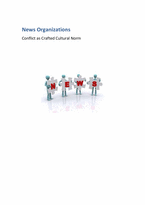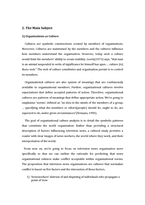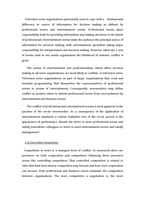1. Introduction
: Conflict in News Organizations and Organizational culture
2. The Main Subject
1) Organizations as Culture
2) Five Major Factors
(normalizing conflict in news organizations)
2-1) Newswoker Distrust and Dispute
2-2) Professional Norms vs. Business Norms
2-3) Professional Norms vs. Entertainment Norms
2-4) Controlled Competition
2-5) Structure of Television News Messages
3. Conclusion :Interaction of the Five Factors
2) Conflicts between professional norms and business norms
3) Conflicts between professional norms and entertainment norms
4) Controlled competition among newsworkers and among news organizations
5) The structure of television news messages
Considered these factors suggest that television news organizations are cultures where conflict is a pattern of expected behavior, and conflict is, therefore, ordinary, routine, and reasonable.
2) Five Major Factors
2-1) Newswoker Distrust and Dispute
Tuchman(1978) argues that the pattern of newsgathering typically leads to support for the status quo. However, Altheide(1984) argues there is a tendency for journalists to cast themselves in opposition to the focus of the status quo. It is not necessary to accept either position to find that newsworkers are characterized by skepticism of sources in general, but are likely to be distrustful of persons obviously presenting a point of view.
Johnstone, slawski, and bowman’s(1976) newsworkers reported a commitment to public responsibility. When the intentions of sources become apparent and the source’s intentions are seen by journalists as being inconsistent with their conception of public responsibility, newsworkers are likely to distrust and dispute the sources. For example, newsworkers are very aware and somewhat accepting that the news secretaries of political candidates attempt to present their candidate in a positive right. However, when news secretaries appear to be deliberately deceiving to protect their candidates for what newsworkers deemed inappropriate reasons, newsworkers may become extraordinarily distrustful.
That is the newsworker can imagine a circumstance, where despite long establishes nonconflict relationships, they would necessarily confront a source. In other words, newsworkers utilize a calculus that includes the legitimate value of disputing sources and conflict when balancing their relationship with sources and the demand for work. The calculus is only made more complex by factors of professionalism, isolation, and group norms, which are discussed below.
2-2) Professional Norms vs. Business Norms
News organizations employ a large number of individuals who work within a set of journalistic professional norms, even though not all employed by those organizations were trained as journalist. Professional norms affect the prevalence of organizational conflict in a number of ways.
We found an organizational culture dominated by business norms, populated by newsworkers who appeared to follow professional norms, and characterized by conflict.
The incompatibility of Professional norms and business norms can produce a variety of effects.












 분야
분야


